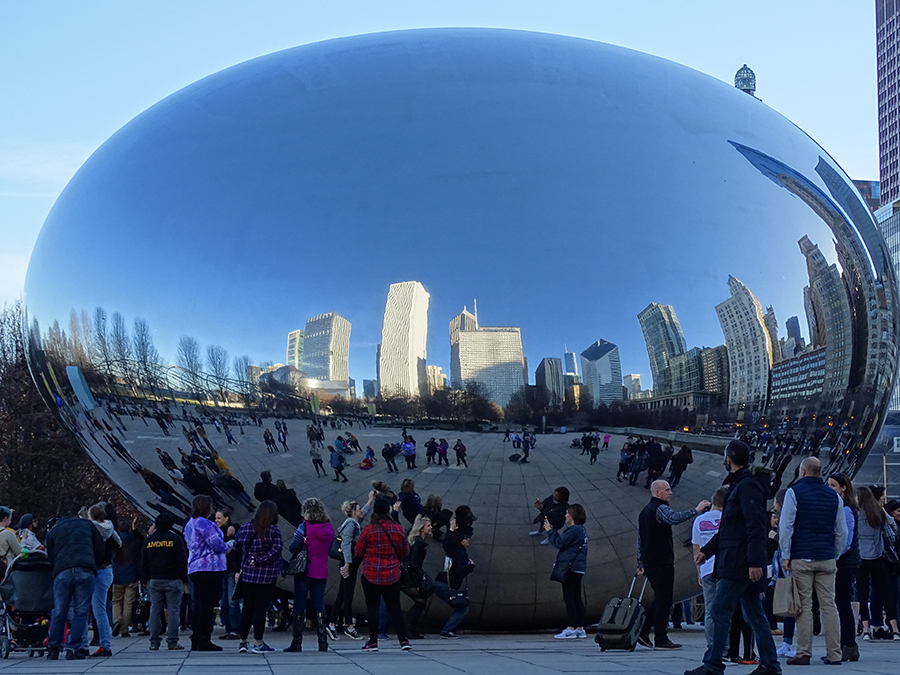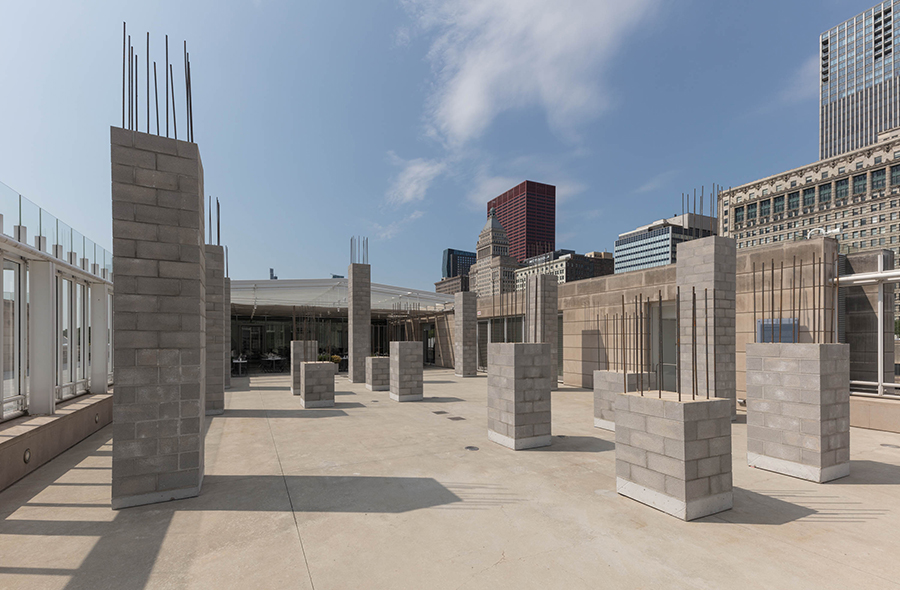Postcommodity and the Unfinished Business of Building a Fairer Chicago
At the Art Institute, an indigenous construction loophole uncovers ugly truths about the city’s racist and classist past
At the Art Institute, an indigenous construction loophole uncovers ugly truths about the city’s racist and classist past

The most famous place in Chicago was only recently a construction site. Millennium Park opened to the public in 2004, at a nexus of wealth and power: a 24.5-acre stretch of waterfront along Michigan Avenue, the city’s most illustrious boulevard, between the opulent former Public Library building and the Art Institute, one of the greatest encyclopaedic museums in the world. The terraced garden is now home to the Jay Pritzker Pavilion, a gaudy bandstand of polished steel designed by Frank Gehry, and Anish Kapoor’s Cloud Gate (2006), an equally shiny monument to Instagram-era vanitas.

There’s a hardscrabble humility, by contrast, to the latest contemporary sculpture installation on the Art Institute’s Bluhm Family Terrace, partly visible from Millennium Park’s mirrored baubles. Its form recalls the construction that preceded them: 18 columns, ranging in height from 1 to 5 metres, have been erected by the artist collective Postcommodity from concrete cinderblock and steel rebar. They rise in neat rows like the ruins of an ancient hypostyle hall, though they also appear critically unfinished; lengths of rebar jut up from their shafts where capitals and ceiling might be. The work, With Each Incentive (2019), could be mistaken for a modest museum expansion underway. The roof columns – or castillos, as they’re known – are a common feature of homes throughout Latin America that make it easier to add an additional floor. Against the glassy skyline of downtown Chicago, they summon visions of suburban Ciudad Juárez and La Paz.
‘It’s a monument to the incomplete, the unfinished, the act of becoming, the act of transition, of growing,’ said Kade L. Twist, who along with Cristóbal Martínez comprises Postcommodity, at a talk the two artists gave at the Art Institute on 26 July. Such notions of flux are at the core of Indigenous spirituality, to which ‘the idea of permanence is antithetical’. Castillos incorporate traditional Indigenous concepts of architectural adaptability and cheap, mass-produced materials, making them perfectly suited for large, tight-knit families living at the dense yet sprawling edges of Latin American cities. The artists tie this resourcefulness to the ingenuity of African-Americans who relocated from Southern states during the Great Migration of the early 20th century, bringing jazz and creole culture to the northern US and giving Chicago the name ‘Chocolate City’. In areas such as the South Side, they built thriving communities with what little they had. Today, immigrants from Central America have resettled there in large numbers, building on this legacy of growth both literally and metaphorically. ‘You’re seeing a model of black self-determination be vindicated by a new population of migrants,’ Twist said.

The history of black homeownership in Chicago, however, is rife with racism and segregation. As Ta-Nehisi Coates argued in his landmark 2014 essay, ‘The Case for Reparations’, decades of redlining by city officials and the Federal Housing Administration corralled black residents into crumbling neighbourhoods and saddled them with insurmountable debt. In what has become a familiar pattern of gentrification, the city has lately taken interest in predominately black neighbourhoods it long neglected, such as Bronzeville, now that private developers have snatched properties from owners there who can no longer afford to maintain them. All this is guided by the neoliberal doctrine of the Chicago School, whose principle figures, the late economists Milton Friedman and Friedrich Hayek, praised the ‘fairness’ of the market from their Hyde Park offices while black South Siders faced eviction blocks away.
The Chicago School was also partially responsible for the US government’s predatory model of economic development in Latin America, culminating in the 1994 North American Free Trade Agreement (NAFTA), which lowered wages in Mexico and flooded the market there with US consumer goods, squeezing many local producers. Postcommodity cite this as another reference for With Each Incentive, a reminder that so much of the housing stock along the border remains unfinished simply because the money ran dry.

The ‘incentive’ to which the work’s title refers is actually a tax break: in countries such as Bolivia and Peru, property taxes cannot be levied on homes while they’re under construction, so their owners often leave them permanently unfinished. Martínez and Twist don’t mention this loophole in the accompanying exhibition text, but it hints at the resourcefulness necessary to survive the economic violence of places like Chicago’s South Side – or post-NAFTA Ciudad Juárez.
The question of money hangs over this show in another more troubling way. During the Q&A at the 26 July talk, an audience member asked the artists how they contend with the ethics of exhibiting at the Art Institute when one of its trustees, A. Steven Crown, owes much of his family fortune to General Dynamics, the defence contractor which, as recently as 2018, made millions from the sale of surveillance equipment to the US Border Patrol. In response, Twist referred to the recent protests which forced Warren B. Kanders from the board of trustees at the Whitney Museum, dismissing them as naïve: ‘You cannot disaggregate violence, slavery or genocide from any dollar bill you put in your pocket,’ he said. In other words, everybody’s compromised. Although a fair point, this echoes the Whitney’s own defence of Kanders, an argument that board members at other museums are likely to deploy when facing criticism for ‘art-washing’ their blood money.

Postcommodity, for their part, maintain the importance of operating from within the museum, an ‘inside’ that here is crucially outside: on a public terrace accessible at all hours, free of charge, to anyone who happens to walk by. Nearby, one can spot Jaume Plensa’s Crown Fountain (2004), an LED-lit water feature in Millennium Park named for the General Dynamics family. The two sculptures face off like two Chicagos: rich and poor, white and non-white. Castillo is Spanish for ‘castle’, and while the columns do resemble shabby turrets, the word conveys a sense of middle-class pride. Unlike the Chicago of oligarchs, Postcommodity’s castle is open to all.
‘Postcommodity: With Each Incentive’ continues at the Art Institute of Chicago through 26 April 2020.
Main image: ‘Postcommodity: With Each Incentive’, 2019, exhibition view. Courtesy: the Art Institute of Chicago























